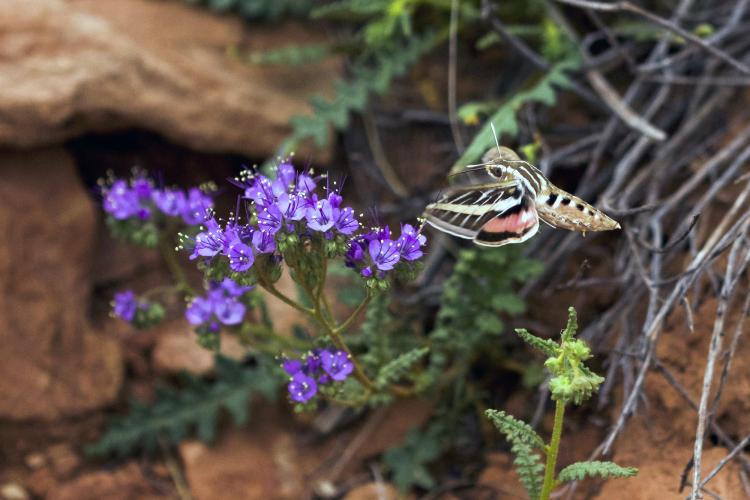White-lined sphinx moths’ flight, agility a marvel
As the sun sank and dusk gathered, a white-lined sphinx moth (Hyles lineata) hovered while sipping nectar from notch-leaf scorpionweed (Phacelia crenulata). The moth’s agility was remarkable — it could hover as it uncoiled its proboscis, or long tubular mouth, and inserted it deftly into a flower, then withdraw it, fly quickly among flowers, stopping abruptly at the next flower full of nectar.

A white-lined sphinx moth was taking nectar from this scorpionweed for more than 10 minutes at Labyrinth Canyon Wilderness in Utah. Photo by Jeff Mitton.
The flight of sphinx moths is a marvel, for while hovering or accelerating the wings beat so fast that they emit a fluttering buzz — wingbeat frequencies are typically 41 cycles (up and down) per second. I am envious, for I can’t do anything 41 times per second. To achieve the rate of wingbeats required for hovering and agile flight, white-lined sphinx moths raise their body temperatures higher than that of humans (98.5 degrees); when evening air temperatures are in the range of 60 to 90 degrees, sphinx body temperatures are maintained between 104 and 108 degrees.
White-lined sphinx moths have an enormous geographic range, from Mexico to southern Canada, so it is not surprising that they take nectar from a wide variety of species. Their preferred group is the 40 species in the genus Oenothera, the evening primroses, which open their white flowers at dusk.
Sphinx moths prefer to fly at night, when they focus on white flowers, but in colder environments they will fly during the day, when they generally choose colored flowers. Sphinx moths have shaped geographic variation of flower color in the blue columbine (Aquilegia caerulea), Colorado’s state flower. At lower elevations, where the moths fly at night, flower colors are usually white, the color most easily detected. At high elevations, cold temperatures frequently force the moths to fly in the daytime, when dark blue flowers are most easily seen. Columbines are dark blue at high elevations where moth pollination success is high during the day, light blue at intermediate elevations and usually white at lower elevations, where moth pollination success is highest at night.
The flight of sphinx moths is a marvel, for while hovering or accelerating the wings beat so fast that they emit a fluttering buzz — wingbeat frequencies are typically 41 cycles (up and down) per second.
Scorpionweed is an annual plant that grows up to 30-inches tall and produces flowers that bloom for three to six weeks. Flowers are arranged in a cyme, a flower cluster with a central stem bearing a series of flowers. The terminal flower develops first and the remainder flower in order, from short lateral branches all on the same side of the stem. Because this flower arrangement is top-heavy, it bends over so that the cyme is reminiscent of the coiled abdomen of a scorpion.
Scorpionweed is aromatic, but not pleasantly so, and I suspect that the unpleasant smell contributes a second reason for the name scorpionweed. The nectar is sweet, but the leaves and stems are covered with stiff hairs that have drops of fluid on them, making them aromatic and sticky. The sharp, stiff hairs are not thorns, but glandular trichomes that exude a fluid containing geranylhydroquinone and smaller amounts of four related compounds that provoke allergic reactions in some people. Reactions to these compounds can cause contact dermatitis, an allergic eczema that may also raise prominent blisters. Symptoms can last several weeks. I did not find any data indicating what proportion of people are allergic to scorpionweed oozing geranylhydroquinone, but should you be an unfortunate one prone to this allergy, it would be worthwhile to remember what scorpionweed looks like so you can avoid the scorpion’s sting.
Population sizes of scorpionweed vary dramatically from year to year, depending on precipitation during winter and early spring. A drought last year made these infrequent flowers, but this year, current snowpack is more than seven times as great as last year. Consequently, this spring has been a banner year for scorpionweed near Factory Butte, Utah. The Butte is surrounded by badlands of Mancos Shale that spread for miles in each direction. This year the nasty dark shale was blanketed by a dense monoculture of scorpionweed that transformed miles of badlands into lovely purple gardens.

